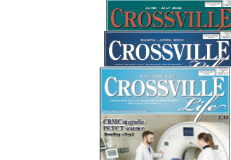By KEVIN J. DONALDSON
Crossville Life Features Editor
A new surgical technique practiced by Cookeville orthopedic surgeon Dr. Greg Roberts is greatly reducing pain and recovery time for hip-replacement patients.
Dr. Roberts, a physician with Tier 1 Orthopedic and Neurosurgical Institute in Cookeville, affiliated with Cookeville Regional Medical Center, has been using the new technique for several months and has performed a couple dozen of them already.
One of his success stories is Crossville’s Susan Tabor, who underwent the new technique on September 24.
“I had been in pain for about five years,” Tabor said. “At one point, I thought it was back pain, but it turned out that I needed a new hip. My recovery has gone wonderfully. To be pain-free after being in pain for so many years is just incredible.”
“Hip replacement surgery is a procedure where we surgically remove a painful hip joint with arthritis, and replace it with an artificial joint made from metal and plastic components,” said Dr. Roberts. “It usually is done when all other treatment options have failed to provide adequate pain relief. The procedure should relieve a painful hip joint, making walking easier.”
“First performed in 1960, hip replacement surgery is one of the most successful operations in all of medicine,” says the American Academy of Orthopedic Surgeons (AAOS) website. “Since 1960, improvements in joint replacement surgical techniques and technology have greatly increased the effectiveness of total hip replacement. According to the Agency for Healthcare Research and Quality, more than 300,000 total hip replacements are performed each year in the United States.”
The hip is one of the body’s largest joints, says the AAOS website, and is a “ball-and-socket” joint. The socket is formed by the acetabulum, part of the large pelvis bone. The ball is the femoral head, which is the upper end of the femur, or thigh bone.
In traditional hip-replacement surgery, surgeons typically made a long incision in the back of the hip area. “In that type of procedure, there were several muscles and tendons that had to be cut,” said Dr. Roberts. “That created more pain following the surgery and a longer recovery time.”
The new technique involves surgeons coming in from the front of the hip in a less invasive way that usually makes a quicker recovery for patients, Dr. Roberts said.
“With the new procedure, we basically just split one muscle and move it to the side,” he said. “This creates much less trauma on the body, reducing pain and recovery time, ideally.”
Tabor is certainly a believer. “I have no pain and can walk, plain and simple,” she said. “I was in (post-operative) therapy for about a week, but really didn’t have to be there that long.
“I was walking without a cane or a walker within five days,” Tabor said. “There was just no need for it. Before the surgery, I did well to walk from my house to my mailbox. I can also now sit for long periods of time without pain, and I just couldn’t do that before.”
Dr. Roberts said with the older, traditional technique, patients would often use a walker for two to three weeks, and then use a cane for two to three weeks. “The new technique is making a big difference for our patients,” he said.
“Dr. Roberts has been just wonderful,” Tabor said. “He’s a miracle worker. Words can’t describe how much I appreciate what he’s done for me. He is very knowledgeable about what he’s doing, he’s caring, and he put no pressure on me. He showed me the x-ray of my hip and explained everything very carefully to me.”
“Susan’s recovery has gone very well,” said Dr. Roberts. “She got up and got going, which is very important. Her pain was relieved early in the process and she’s been very pleased.
“I’ve been performing the new technique for about seven or eight months now, on close to 25 patients,” Dr. Roberts said. “We’re very pleased with the results so far. We want to minimize pain and reduce recovery times for our patients, and this helps us do that.”
Dr. Roberts attended two courses to learn the procedure, and is thought to be the only physician between Knoxville and Nashville performing it.
Dr. Roberts added that advanced surgical techniques and prosthetics are increasing the amount of time hip replacement will last.
Dr. Roberts comes to the Cookeville Regional Medical Center clinic at Fairfield Glade every other Friday, and Tier 1’s Dr. John Turnbull comes every other Tuesday, so the group has a doctor at the clinic one day every week. The clinic is located at 4929 Peavine Road.
Tabor’s surgery was performed at CRMC, and she did her therapy in Crossville.
•
Cookeville Regional Medical Center employs a staff of more than 2,000, has more than 200 on its active and courtesy medical staffs, and is a national award-winning, state-of-the-art regional medical center that serves the entire 14-county Upper Cumberland region. For more information, you can visit the Cookeville Regional Medical Center website.








